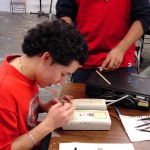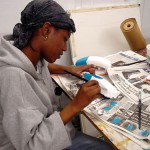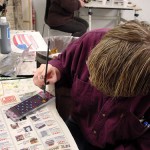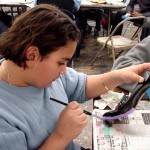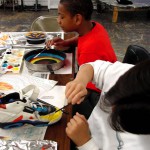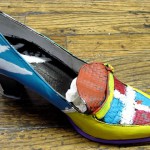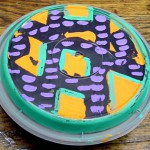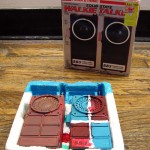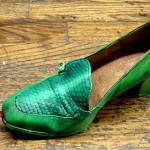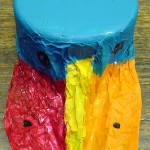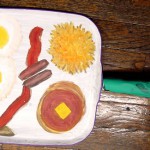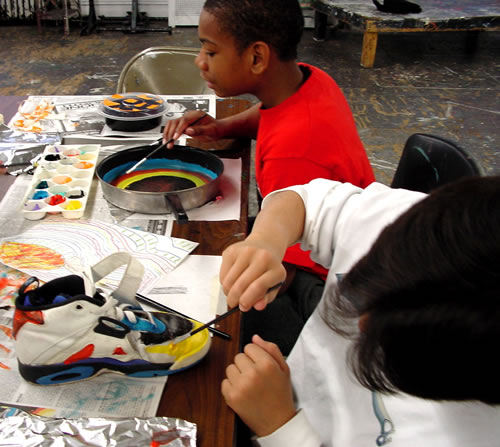
Categories
- Curriculum: Art | Art Criticism | Language Arts
- Age/Grade: Middle School | Above 14
- Subject: Drawing | Writing | Analysis and Theory
- Materials: Mixed Media | Pencils | Paint
- Institution: School of Visual Arts
- Location: New York, New York
- Duration: 2 - 3 Classes
Description
After examining "readymade" artwork by several influential 20th Century artists, these high school students created sculptures by painting on "everyday objects". Offering both an art history and an art-making component, this lesson allows students to analyze and synthesize the creative process for themselves.
Objective
Students will be able to observe, describe, and interpret works of art by Keith Haring, Robert Rauschenberg, and Marcel Duchamp.
Students will develop individual and group communication skills by practicing to articulate ideas and opinions while also learning to listen and respond to others.
Students will cultivate deductive reasoning skills by practicing to gather clues, building evidence, and framing fomed conclusions.
Students will strengthen their ability to make artistic choices that communicate a specific idea.
Students will acquire the ability to make a sculpture using everyday objects and paint.
Students will gain confidence in discussing works of art.
Students will gain an appreciation of art and art history.
Students will realize that varying opinions about art can be discussed and debated.
Students will expand their understanding of what art can be by examining the idea of "readymades".
Resources
Information on Marcel Duchamp
Information on Robert Rauschenberg
Information on "Readymades"
Information on the art movement known as Dada or Dadaism
Materials
Acrylic paint
Found objects
Water buckets
Paint brushes
Paint & painting supplies
Sketching paper
Colored pencils
Pencils
Procedure
MOTIVATION
We will look at and discuss images of everyday objects that are recognized as art by Keith Haring, Robert Rauschenberg, and Marcel Duchamp.
QUESTIONS
1. What is this? (Show a picture of Duchamp's urinal)
2. What makes you say that?
3. Is this art?
4. What is art? Can anything be art?
5. What do you think the artist is saying about this work of art?
6. How does placing an object in a museum change an object?
7. How does calling something art change an object?
8. How does painting on an object change the object?
9. What are some things that can be painted on this object?
PROCEDURE
Setting up: before class (20 minutes)
1. Prepare water buckets, brushes, acrylic paint, everyday objects, paper, and pencils to be ready for distribution.
2. Make sure visuals are in order for discussion.
Class time: (1hour and 30 minutes)
Discussion: (15 minutes)
1. Using open-ended questions, engage the students in a class discussion about the visuals. The object of the discussion is to see how everyday objects have been used by recognized artists and to discuss the question "can anything be considered art?"
2. Ask student to bring in an object that they don't mind turning into art- an old phone, a basket, a hairbrush, a lamp... anything. Just make sure they have their parent or guardian's permission.
Demonstration: (15 minutes)
1. Show the class a finished example of a sculpture created by painting on an everyday object.
2. Demonstrate sketching the object and brainstorm with the class what are some ideas in which the everyday object can be turned into art by looking at the physical attributes of the object and its function.
3. Demonstrate how to use acrylic paint. Warn the students not to put too much water into the paint when painting on an everyday object.
Drawing and painting time: (2 hours)
1. Hand out the pencils and drawing paper.
2. Students will sketch their objects and plan what they will be painting on the objects.
3. After sketches are done hand out acrylic paint, water, and brushes.
4. Students will then paint on their objects. (This painting should be minimal, as fully transforming the piece with paint will remove the process of using a creating a "readymate" piece of art")
SUMMARY
We will have a class discussion about the finished sculptures.
Extensions
NY STATE STANDARDS EMPLOYED
1. Creating, Performing and Participating in the Arts. Students will create sculptures using everyday objects and paint.
2. Knowing and Using Art Resources and Materials. Students will sketch from objects and paint on them using acrylic paint.
3. Responding and Analyzing Works of Art. Students will actively engage in a class discussion by observing, describing, and interpreting artwork by Keith Haring, Robert Rauschenberg, and Marcel Duchamp.
The author of this lesson, Wan Ling Li, a student of the School of Visual Arts in NYC, is the 2002-2003 scholarship recipient of the Keith Haring Scholarship award. This project was a collaboration with The School of Visual Arts & The Liberty Partnership Program* in New York City.
To find out more about The Keith Haring Foundation Scholarship offered through the School of Visual Arts, please contact:
Director, School of Visual Arts/Visual Arts Foundation, 15 Gramercy Park South, NYC 10003.
*The Liberty Partnership Program (LPP) is for students enrolled in 5th through 12th grades. LPP targets students who have been identified as being at-risk for dropping out of school because of poor academic performance, truancy, discipline, family circumstances, negative peer pressure and other documented factors.
